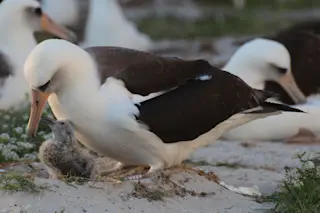Wisdom's mate cares for the newly hatched chick, named Kūkini. (Credit: Kiah Walker/USFWS Volunteer) The oldest known wild bird continued her reign as the world’s most aged avian mother. Wisdom, a Laysan albatross nesting at the Midway Atoll National Wildlife Refuge, laid an egg back in November that started hatching on Feb. 1 while under the care of her mate, according to the the U.S. Fish and Wildlife Service. It's estimated that this is the 40th time 65-year-old Wisdom has brought a new life into the world, and her chick was named Kūkini — Hawaiian for messenger. Wisdom returned from one of her solitary hunting trips, which can last up to a month, several days after Kūkini hatched. Wisdom took over care of the chick, regurgitating her catch of squid and fish to nourish her offspring. “Wisdom is an iconic symbol of inspiration and hope,” noted Robert Peyton, refuge manager, ...
At Age 65, Wisdom the Albatross Hatches a Healthy Chick
Wisdom the Laysan albatross proves age is just a number as the oldest known wild bird mother hatches a chick named Kūkini.
More on Discover
Stay Curious
SubscribeTo The Magazine
Save up to 40% off the cover price when you subscribe to Discover magazine.
Subscribe













